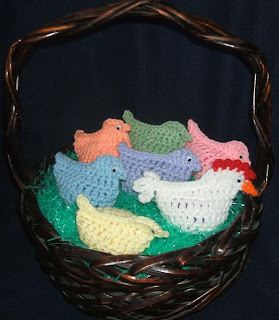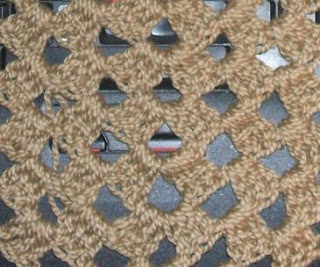*This pattern has NOT been tested. If you find any mistakes please leave a comment here and I will correct.
Also, I don't have a pic to post just yet, so if you work this up and would like to share a link to a pic in the comments section it would be greatly appreciated!
MATERIALS
(US) size H hook
1 skein Caron Simply Soft yarn; Blue Mint (or desired color)
tapestry needle
GAUGE (worked in seed st)
15 sts = 4 inches
14 rows = 4 inches
FINISHED SIZE
Adult-One Size Fits Most (9 inches tall X 26 inches around)
SPECIAL STITCHES & TECHNIQUES
"back hump" of starting chain: Turn your starting chain over so the back is facing you, notice the single strand in the middle of the chain forms a "hump". Your stitches will be worked into that hump. For more info see: http://www.stitchdiva.com/custom.aspx?id=191
(This method for working into the starting chain gives a more finished look to the beginning edge of your work. If you are uncomfortable with this method, the traditional method of working into the starting chain may be used.)
FPdc (front post double crochet): yo, from the front, insert hook around the post of the corresponding dc of the previous row, yo and draw up loop, yo, draw through 2 loops, yo, draw through 2 loops.
BPdc (back post double crochet) = yo, from the back, insert hook around the post of the corresponding dc of the previous row, yo and draw up loop, yo, draw through 2 loops, yo, draw through 2 loops.
Closing the beginning chain: Thread tapestry needle with the tail from the beginning ch, working on opposite side of starting chain, insert needle on right side and under free loops of 2nd dc made in round 1, pull snug but not tight (it should look like the top of a sc) and secure end at base of first ch of starting chain.
leaving 6 - 8 inch long tail, ch 106, do not join (See note above)
Round 1: working in the back hump of starting chain (see note above) dc in 4th ch from hook and in each ch across, join with sl st in top of beg ch 3. (104 sts)
Rounds 2-4: ch 3, work FPdc in next st, (work BPdc in next st, work FPdc in next st) around, join with sl st in top of beg ch 3.
Round 5: ch 1, sc in same st, dc in next st, (sc in next st, dc in next st) around, join with sl st in beg sc.
Round 6: ch 3, sc in next st, (dc in next st, sc in next st) around, join with sl st in beg ch 3.
Rounds 7-26: Repeat rounds 5 and 6.
Round 27: ch 3, dc in each st around, join with sl st in top of beg ch 3.
Rounds 28-30: Repeat rounds 2-4, fasten off. Close beginning ch. (see note above) Weave in ends.
Friday, March 12, 2010
Saturday, March 6, 2010
Friday, March 5, 2010
Here Comes Peter Cottontail
Today is bright, sunny, and warm. I hope Spring has finally sprung! We had entirely too much cold and bad weather this year. I'm ready for some color! Spring Fever has definately set in, and here's my proof:
The bunny I came up with on my own...
But I'm sure you recognize these guys:

Mama chicken and her baby pastel chicks were a staple in our house when I was little. I hadn't thought about them in years until a friend wanted me to make her some recently. This is what I came up with:

I have the patterns written and will post them tomorrow. Hope you enjoy!! :)
The bunny I came up with on my own...
But I'm sure you recognize these guys:
Mama chicken and her baby pastel chicks were a staple in our house when I was little. I hadn't thought about them in years until a friend wanted me to make her some recently. This is what I came up with:
I have the patterns written and will post them tomorrow. Hope you enjoy!! :)
Thursday, March 4, 2010
Knitting Daily
I watched a tv show today that kind of took me by surprise. I had set the DVR on a whim a few days ago when I saw the title. The show was Knitting Daily. The episode was #110: All About Texture. Although I do knit, my expertise in that area is pretty much limited to simple dishcloths and other simple projects. So I thought what could it hurt, I might learn something new. And learn something new I did, but not about knitting!
I was happy to see that the show is crochet friendly! Kim Werker, billed as their "Crochet Ace," is one of the regulars on the show. On today's episode she met with Robyn Chachula who showed her a different kind of double crochet stitch. It is called a "Linked Double Crochet" (abreviated Ldc). It creates a more solid fabric that is great for wearables. She used the stitch when designing her Rosemary Sweater which was featured in the fall 2007 issue of Interweave Crochet. Robyn is also offering a free download of the Rosemary Sweater via the Knitting Daily webiste.
In addition to the crochet segment, they talked about different yarns and thier textures. Even though the information was primarily geared toward kitters, I think there was much to be learned by crocheters as well. After all, yarn is NOT knitting exclusive! I will definately be watching Knitting Daily on a regular basis.
If you want to check it out, it's on PBS. You can look for the show in your area on the Knitting Daily website.
I was happy to see that the show is crochet friendly! Kim Werker, billed as their "Crochet Ace," is one of the regulars on the show. On today's episode she met with Robyn Chachula who showed her a different kind of double crochet stitch. It is called a "Linked Double Crochet" (abreviated Ldc). It creates a more solid fabric that is great for wearables. She used the stitch when designing her Rosemary Sweater which was featured in the fall 2007 issue of Interweave Crochet. Robyn is also offering a free download of the Rosemary Sweater via the Knitting Daily webiste.
In addition to the crochet segment, they talked about different yarns and thier textures. Even though the information was primarily geared toward kitters, I think there was much to be learned by crocheters as well. After all, yarn is NOT knitting exclusive! I will definately be watching Knitting Daily on a regular basis.
If you want to check it out, it's on PBS. You can look for the show in your area on the Knitting Daily website.
Wednesday, March 3, 2010
Another History Lesson
I promise to keep this one brief! I just wanted to follow up a bit on my previous posts about George Washington Carver and antique patterns.
Undoubtedly, one of the most popular, as well as historical, crochet items that was ushered into the new millennium has been the shawl. Many Prayer Shawl Ministries have emerged in the past decade or so in an effort to provide comfort and emotional support to those experiencing hardship and loss. What once was worn primarily as a garment of necessity, has become one of comfort and support.
I thought it would be fun to re-create a Civil War Era Shawl and share the pattern with everyone for your ministries, personal use, or participation in Civil War Reenactment. Keep an eye out for the pattern within the next week. In the meanwhile, here's a sneak preview:

For more details about the history of crochet, Ruthie Marks has provided a wonderfully detailed historical timeline of crochet. It is posted at Crochet.org. (opens as a PDF)
Undoubtedly, one of the most popular, as well as historical, crochet items that was ushered into the new millennium has been the shawl. Many Prayer Shawl Ministries have emerged in the past decade or so in an effort to provide comfort and emotional support to those experiencing hardship and loss. What once was worn primarily as a garment of necessity, has become one of comfort and support.
I thought it would be fun to re-create a Civil War Era Shawl and share the pattern with everyone for your ministries, personal use, or participation in Civil War Reenactment. Keep an eye out for the pattern within the next week. In the meanwhile, here's a sneak preview:
For more details about the history of crochet, Ruthie Marks has provided a wonderfully detailed historical timeline of crochet. It is posted at Crochet.org. (opens as a PDF)
Tuesday, March 2, 2010
National Women's History Month
Yesterday I talked about National Crochet Month, well March is also National Women's History Month. What started just a few decades ago as International Women's Day, has evolved to encompass a full month dedicated to educating students of all ages about the importance of women throughout history.
This year's theme is Writing Women Back into History. Although it may be politically incorrect in today's society, it is a fact, historically speaking, that crochet and most other needlewark was primarily seen as "woman's work". Antique Pattern Library is working to preserve the the art form by making available the many patterns our foremothers used during the 19th and early 20th centuries.
Included in the library are crochet, knitting, tatting, embroidery, needle lace and other kinds of needlework patterns. No matter your needleart of choice, you will surely find something there that will help you give you a sense of needleart history.
This year's theme is Writing Women Back into History. Although it may be politically incorrect in today's society, it is a fact, historically speaking, that crochet and most other needlewark was primarily seen as "woman's work". Antique Pattern Library is working to preserve the the art form by making available the many patterns our foremothers used during the 19th and early 20th centuries.
Included in the library are crochet, knitting, tatting, embroidery, needle lace and other kinds of needlework patterns. No matter your needleart of choice, you will surely find something there that will help you give you a sense of needleart history.
Subscribe to:
Posts (Atom)
